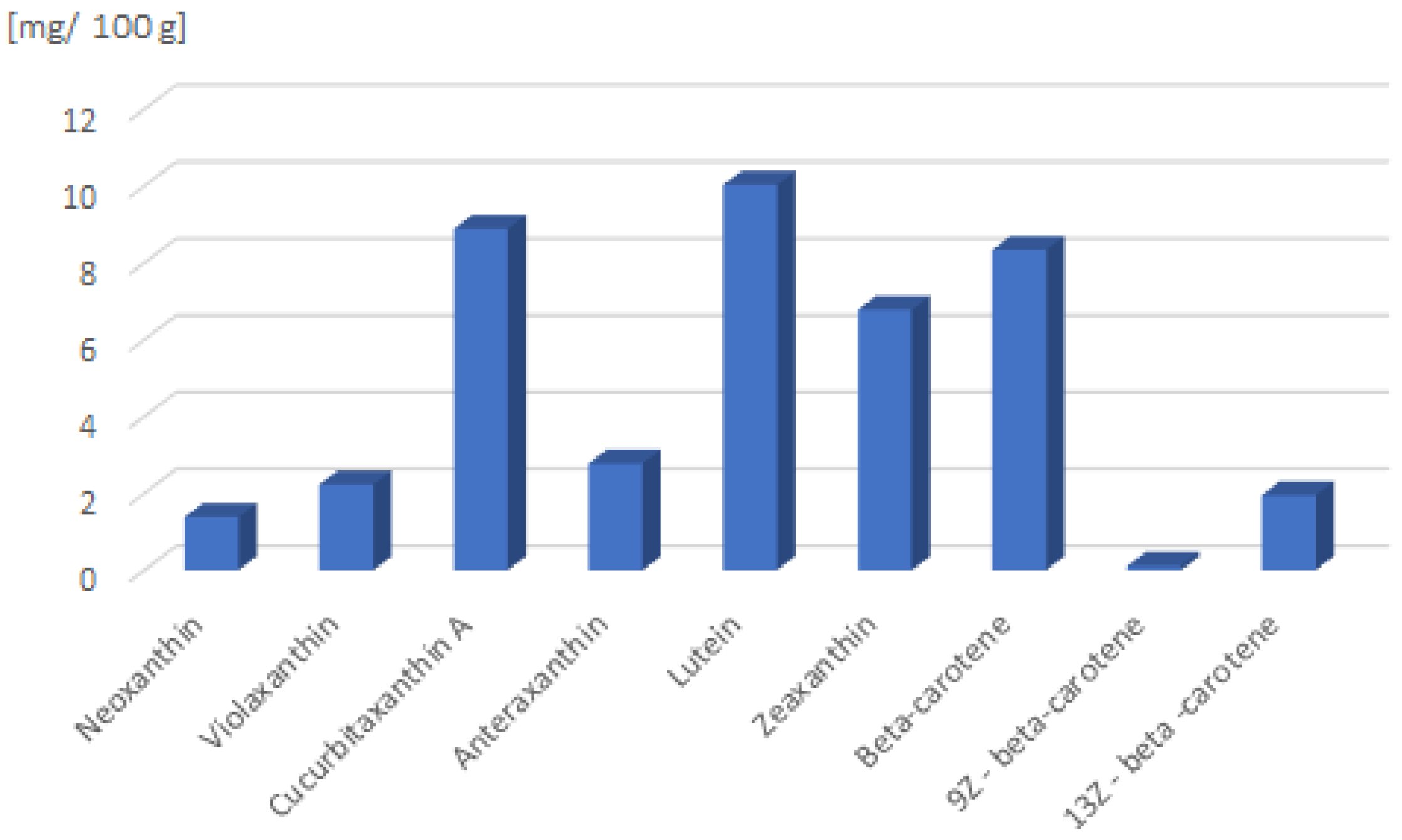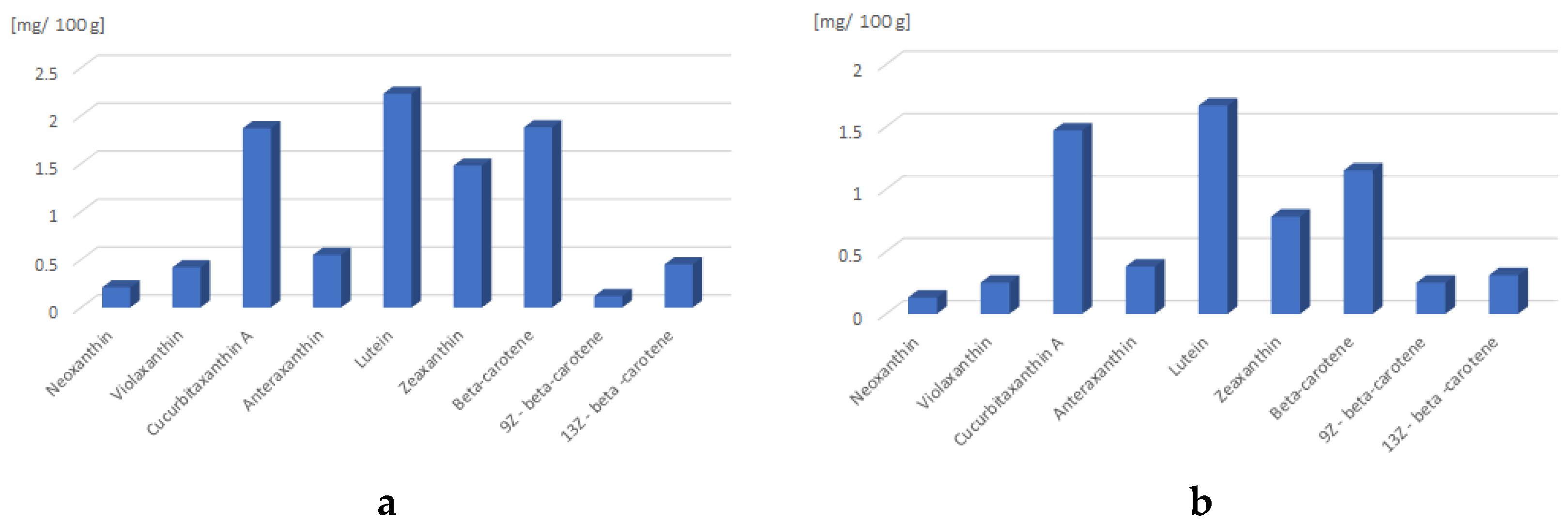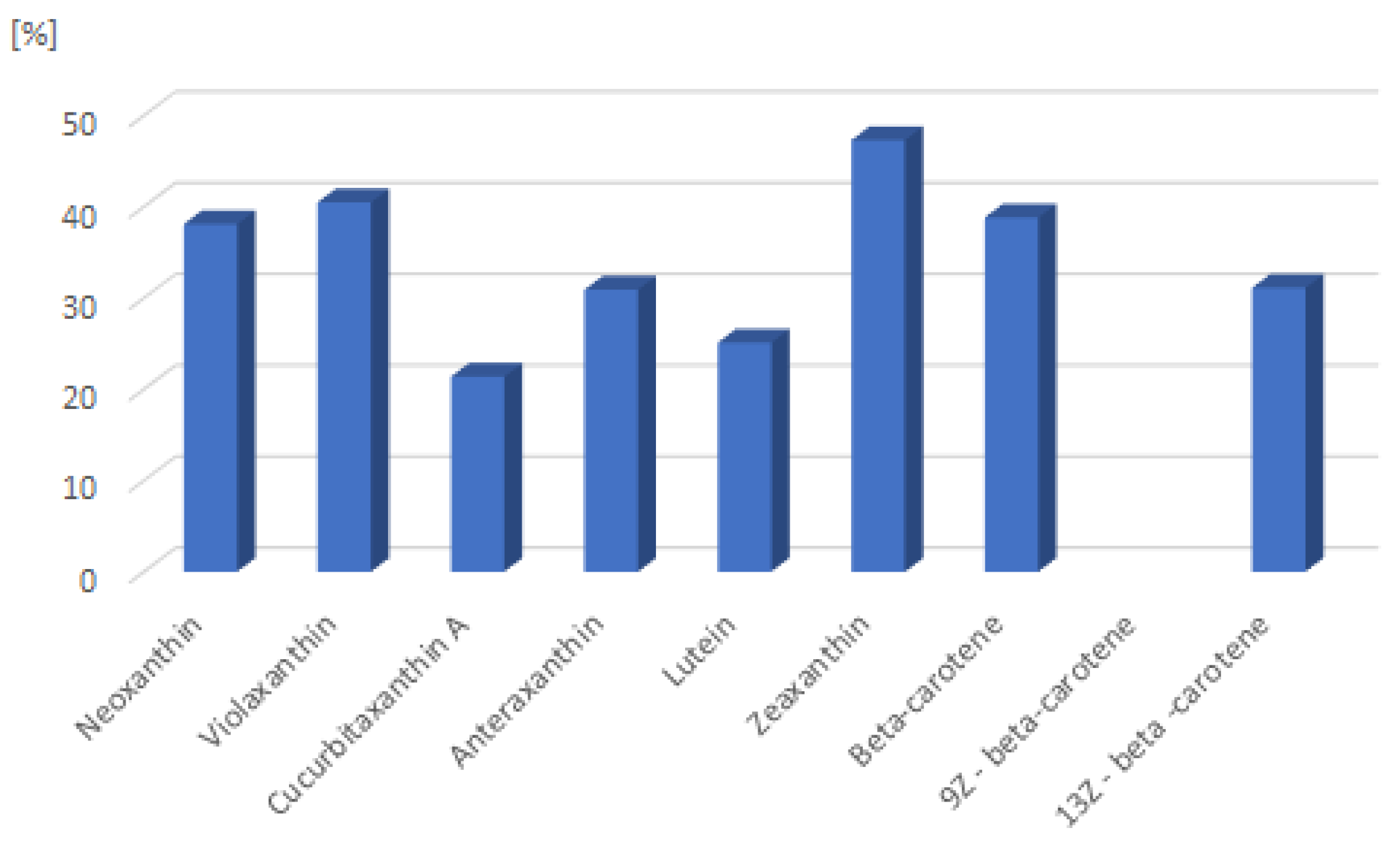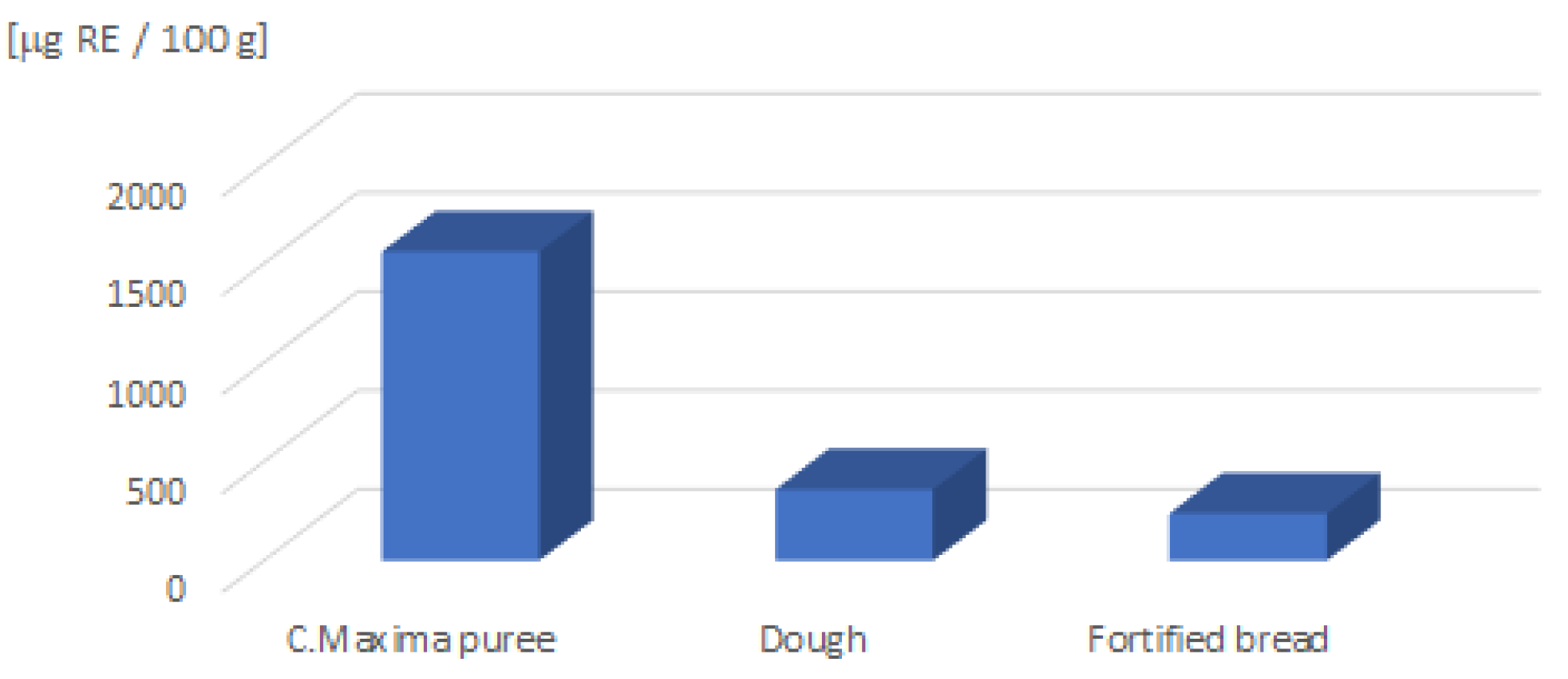Effect of Thermal Processing on Carotenoids in Fortified Bread †
Abstract
1. Introduction
2. Materials and Methods
2.1. Materials
2.2. Biological Material & Bread Fortification
2.3. Sampling and Sample Preparation
2.4. HPLC Analysis
2.5. Data Processing
3. Results and Discussion
4. Conclusions
- HPLC analysis demonstrated that the major carotenoids in fortified bread were lutein, cucurbitaxanthin A and β-carotene. It also highlighted the stability of the targeted compounds and the change in provitamin A activity as a result of thermal processing during baking; the most stable carotenoids proved to be lutein and cucurbitaxanthin A.
- The behavior of the involved carotenoids can provide relevant information for nutritional studies.
- Bread fortified with baked Cucurbita is not only a possible solution for combating vitamin A deficiency, but it is also a true functional food.
- Bread products fortified with naturally occurring carotenoids may be of interest to consumers because of the health benefit of the antioxidant effect, as compared with non-fortified products. The use of natural sources of carotenoids, such as Cucurbita maxima fruits, can also increase consumer acceptance and compliance.
- Fortified bread can also open new market opportunities for producers; being a solution to a serious public health issue, it can be used as a selling point for health-conscious consumers.
Supplementary Materials
Funding
Institutional Review Board Statement
Informed Consent Statement
Data Availability Statement
Conflicts of Interest
References
- Akhtar, S.; Ahmed, A.; Randhawa, M.A.; Atukorala, S.; Arlappa, N.; Ismail, T.; Ali, Z. Prevalence of vitamin A deficiency in South Asia: Causes, outcomes, and possible remedies. J. Health Popul. Nutr. Nutr. 2013, 31, 413–423. [Google Scholar] [CrossRef] [PubMed]
- Gernand, A.D.; Schulze, K.J.; Stewart, C.P.; West, K.P., Jr.; Christian, P. Micronutrient deficiencies in pregnancy worldwide: Health effects and prevention. Nat. Rev. Endocrinol. 2016, 12, 274–289. [Google Scholar] [CrossRef] [PubMed]
- Aghalari, Z.; Dahms, H.U.; Sillanpää, M. Evaluation of nutrients in bread: A systematic review. J. Health Popul. Nutr. 2022, 41, 50. [Google Scholar] [CrossRef] [PubMed]
- Ibrahim, U.K.; Salleh, R.M.; Maqsood-ul-Haque, S.N.S. Bread towards functional food: An overview. Int. J. Food Eng. 2015, 1, 39–43. [Google Scholar] [CrossRef]
- Muntean, E.; Rotar, I. HPLC assessment of provitamin A carotenoids from Cucurbita maxima Duch. ex. lam.(Mariţa cultivar) fruits. Res. J. Agric. Sci. 2010, 42, 517–520. [Google Scholar]
- Muntean, E.; Muntean, N.; Duda, M.M. Cucurbita maxima Duch. as a medicinal plant. Hop Med. Plants 2013, 1, 75–80. [Google Scholar]
- Muntean, E. Carotenoids in Cucurbita fruits. In Proceedings of the 2nd International Electronic Conference on Nutrients, On-line, 15–30 March 2022; Available online: https://sciforum.net/manuscripts/12381/slides.pdf (accessed on 15 April 2023).
- Perera, C.O.; Yen, G.M. Functional properties of carotenoids in human health. Int. J. Food Prop. 2007, 10, 201–230. [Google Scholar] [CrossRef]
- Rao, A.V.; Rao, L.G. Carotenoids and human health. Pharmacol. Res. 2007, 55, 207–216. [Google Scholar] [CrossRef] [PubMed]
- Boon, C.S.; McClements, D.J.; Weiss, J.; Decker, E.A. Factors influencing the chemical stability of carotenoids in foods. Crit. Rev. Food Sci. Nutr. 2010, 50, 515–532. [Google Scholar] [CrossRef] [PubMed]
- Christaki, E.; Bonos, E.; Giannenas, I.; Florou-Paneri, P. Functional properties of carotenoids originating from algae. J. Sci. Food Agr. 2013, 93, 5–11. [Google Scholar] [CrossRef] [PubMed]
- Feltl, L.; Pacakova, V.; Stulik, K.; Volka, K. Reliability of carotenoid analyses: A review. Curr. Anal. Chem. 2005, 1, 93–102. [Google Scholar] [CrossRef]
- Zhao, X.; Liang, K.; Zhu, H. Carotenoids in Cereals and Related Foodstuffs: A Review of Extraction and Analysis Methods. Food Rev. Int. 2022, 14, 1–16. [Google Scholar] [CrossRef]
- Muntean, E.; Muntean, N.; Modoran, C. HPLC analysis of carotenoids in bread. Sci. Res. Agroaliment. Process. Technol. 2004, 10, 186–190. [Google Scholar]
- Britton, G. UV/Visible spectroscopy. In Carotenoids—Vol. 1: Spectroscopy; Britton, G., Liaaen-Jensen, S., Pfander, H., Eds.; Birkhauser: Basel, Switzerland, 1996; pp. 13–62. [Google Scholar]
- World Health Organization. Vitamin and Mineral Requirements in Human Nutrition, 2nd ed.; World Health Organization: Geneva, Switzerland, 2004; pp. 24–26. Available online: http://apps.who.int/iris/bitstream/handle/10665/42716/9241546123.pdf?sequence=1 (accessed on 15 April 2023).




Disclaimer/Publisher’s Note: The statements, opinions and data contained in all publications are solely those of the individual author(s) and contributor(s) and not of MDPI and/or the editor(s). MDPI and/or the editor(s) disclaim responsibility for any injury to people or property resulting from any ideas, methods, instructions or products referred to in the content. |
© 2023 by the author. Licensee MDPI, Basel, Switzerland. This article is an open access article distributed under the terms and conditions of the Creative Commons Attribution (CC BY) license (https://creativecommons.org/licenses/by/4.0/).
Share and Cite
Muntean, E. Effect of Thermal Processing on Carotenoids in Fortified Bread. Eng. Proc. 2023, 37, 70. https://doi.org/10.3390/ECP2023-14694
Muntean E. Effect of Thermal Processing on Carotenoids in Fortified Bread. Engineering Proceedings. 2023; 37(1):70. https://doi.org/10.3390/ECP2023-14694
Chicago/Turabian StyleMuntean, Edward. 2023. "Effect of Thermal Processing on Carotenoids in Fortified Bread" Engineering Proceedings 37, no. 1: 70. https://doi.org/10.3390/ECP2023-14694
APA StyleMuntean, E. (2023). Effect of Thermal Processing on Carotenoids in Fortified Bread. Engineering Proceedings, 37(1), 70. https://doi.org/10.3390/ECP2023-14694




